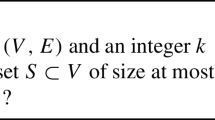Abstract
The cluster deletion problem (CD) asks for transforming a given graph into a disjoint union of cliques by removing as few edges as possible. CD is among the most studied combinatorial optimization problem and, for general graphs, it is NP-hard. In the present paper, we identify a new polynomially solvable CD subproblem. We specifically propose a two-phase polynomial-time algorithm that optimally solves CD on the class of (butterfly,diamond)-free graphs. For this latter class of graphs, our two-phase algorithm provides optimal solutions even for another clustering variant, namely, cluster editing. Then, we propose a 2-optimal CD algorithm dedicated to the super-class of diamond-free graphs. For this class, we also show that CD, when parameterised by the number of deleted edges, admits a quadratic-size kernel. Finally, we report the results of experiments carried out on numerous diamond-free graphs, showing the effectiveness of the proposed approximate algorithm in terms of solution quality.



Similar content being viewed by others
References
Bonomo F, Durn G, Napoli A, Valencia-Pabon M (2015) A one-to-one correspondence between potential solutions of the cluster deletion problem and the minimum sum colouring problem, and its application to \(P_4\)-sparse graphs. Inf Process Lett 115:600–603
Bonomo F, Durn G, Valencia-Pabon M (2015) Complexity of the cluster deletion problem on subclasses of chordal graphs. Theor Comput Sci 600:59–69
Bron C, Kerbosch J (1973) Finding all cliques of an undirected graph (algorithm 457). Commun ACM 16(9):575–576
Cazals F, Karande C (2008) A note on the problem of reporting maximal cliques. Theor Comput Sci 407(1–3):564–568
Cygan M, Fedor V, Fomin FV, Kowalik L, Lokshtanov D, Marx D, Pilipczuk M, Pilipczuk M, Saurabh S (2015) Parameterized algorithms. Springer, Berlin
Edmonds J (1965) Maximum matching and a polyhedron with 0,1-vertices. J Res Natl Bureau Standards B Math Math Phys 69B:125–130
Fellows MR, Guo J, Komusiewicz C, Niedermeier R, Uhlmann J (2011) Graph-based data clustering with overlaps. Discrete Optim 8:2–17
Gao Y, Hare DR, Nastos J (2013) The cluster deletion problem for cographs. Discrete Math 313(23):2763–2771
Grüttemeier N, Komusiewicz C (2018) On the relation of strong triadic closure and cluster deletion. In: Proceedings of the \(44^{{\rm th}}\) WG. LNCS, (11159), pp 239–251. Springer
Guo J (2009) A more effective linear kernelization for cluster editing. Theor Comput Sci 410:718–726
Johnson DS, Papadimitriou CH, Yannakakis M (1988) On generating all maximal independent sets. Inf Process Lett 27(3):119–123
Komusiewicz C, Uhlmann J (2012) Cluster editing with locally bounded modifications. Discrete Appl Math 160(15):259–2270
Lancichinetti A, Fortunato S, Radicchi F (2008) Benchmark graphs for testing community detection algorithms. Phys Rev E 78:046110
Makino K, Uno T (2004) New algorithms for enumerating all maximal cliques. In: Scandinavian workshop on algorithm theory, pp 260–272. Springer
Mamalis B, Gavalas D, Konstantopoulos C, Pantziou G (2009) Clustering in wireless sensor networks. In: RFID and sensor networks. CRC Press, pp 343–374
Natanzon A, Shamir R, Sharan R (2001) Complexity classification of some edge modification problems. Discrete Appl Math 113:109–128
Pipenbacher PS, Schneckener A, Schnhuth S, Schomburg A, Schrader DR (1964) ProClust: improved clustering of protein sequences with an extended graph-based approach. Bioinformatics 18(Suppl 2):182–191
Shamir RS, Tsur RD (2002) Cluster graph modification problems. Discrete Appl Math 144(12):173–182
Sharan R, Maron-Katz A, Shamir R (2003) CLICK and EXPANDER: a system for clustering and visualizing gene expression data, Bioinformatics, vol 19, pp 1787–1799, 2003. In: A preliminary version appeared in proceedings of the 8th international conference on intelligent systems for molecular biology (ISMB), pp 307–316, AAAI Press, New York, 2000
Tomita E, Kameda T (2007) An efficient branch-and-bound algorithm for finding a maximum clique with computational experiments. J Glob Optim 37(1):95–111
Tsukiyama S, Ide M, Ariyoshi H, Shirakawa I (1977) A new algorithm for generating all the maximal independent sets. SIAM J Comput 6(3):505–517
Ur Rehman S, Ullah KA, Fong S (2012) Graph mining: A survey of graph mining techniques. In: International conference on digital information management, ICDIM, pp 88–92
Author information
Authors and Affiliations
Corresponding author
Additional information
Publisher's Note
Springer Nature remains neutral with regard to jurisdictional claims in published maps and institutional affiliations.
Rights and permissions
About this article
Cite this article
Malek, S., Naanaa, W. A new approximate cluster deletion algorithm for diamond-free graphs. J Comb Optim 39, 385–411 (2020). https://doi.org/10.1007/s10878-019-00477-z
Published:
Issue Date:
DOI: https://doi.org/10.1007/s10878-019-00477-z




